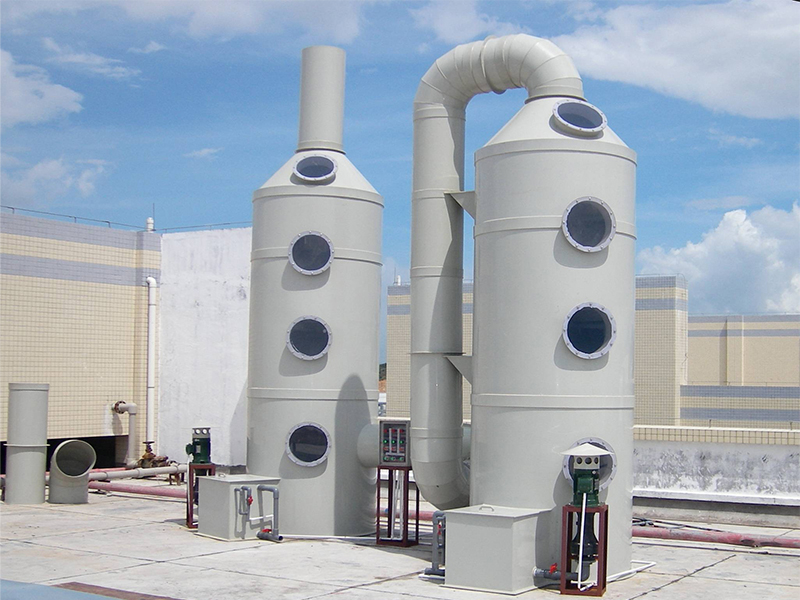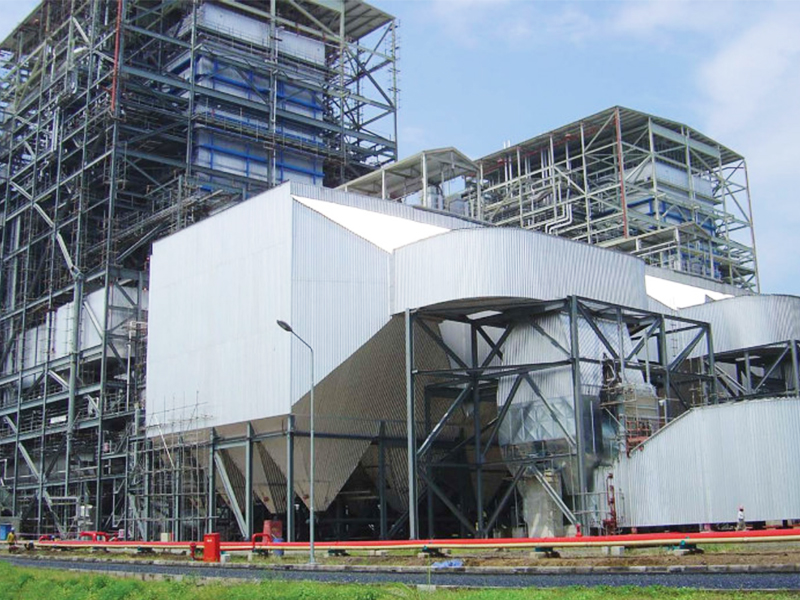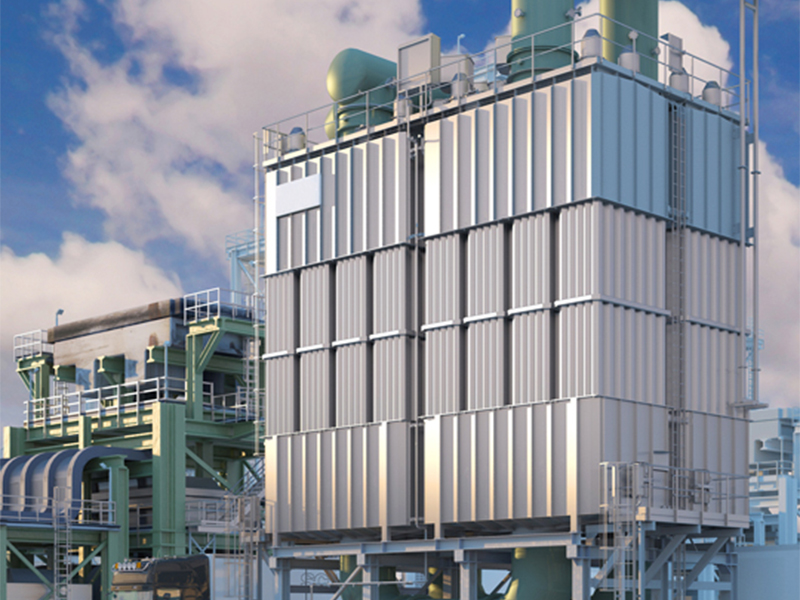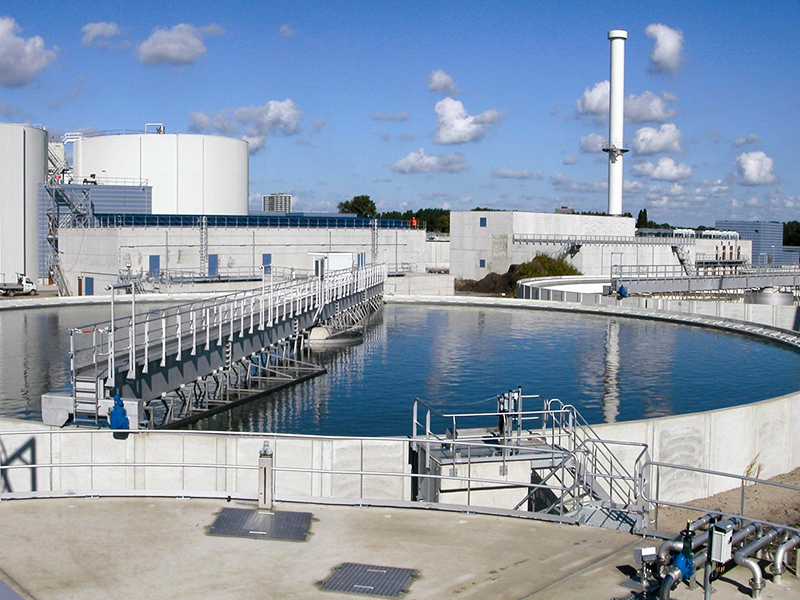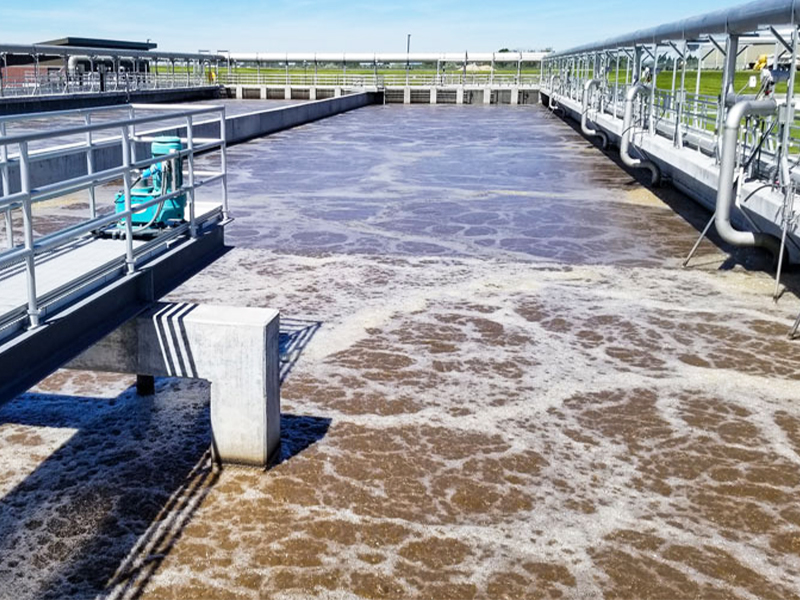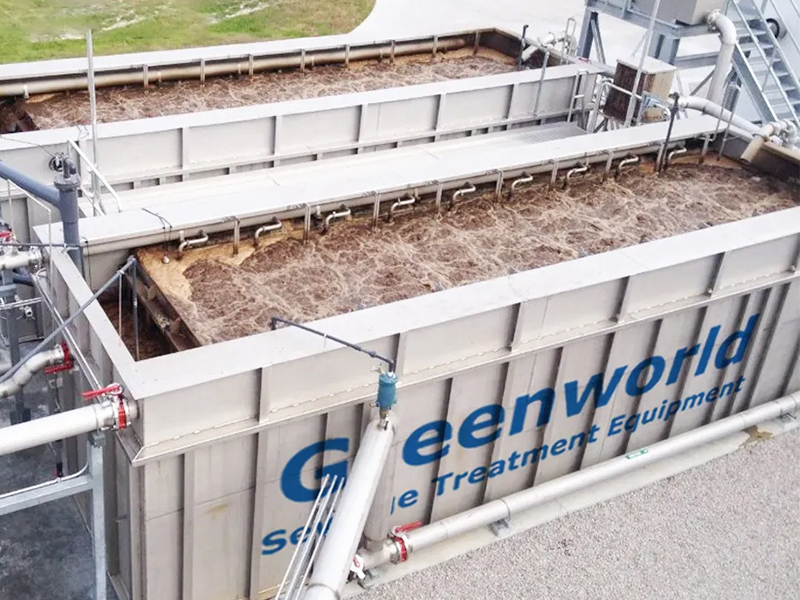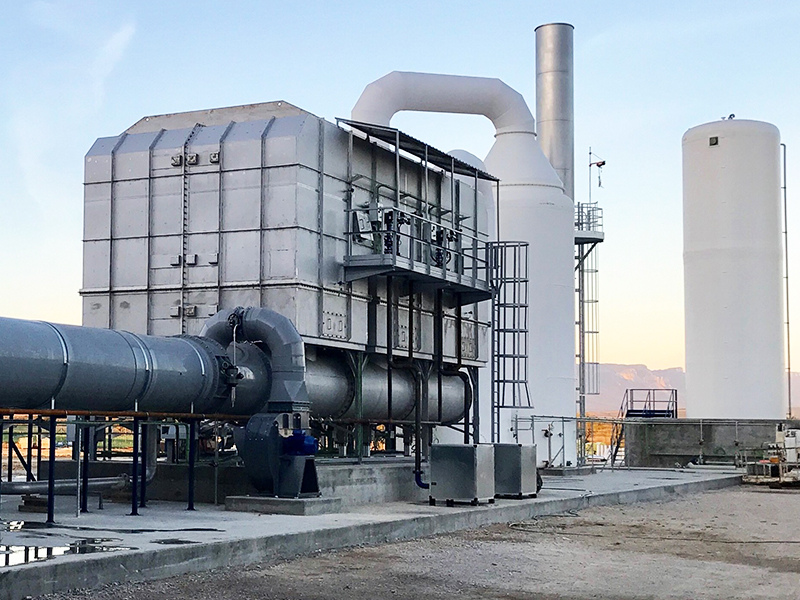0102030405
Industrial Ultrafiltration Water Treatment Plant UF Membrane Systems
Characteristics of ultrafiltration system technology
Ultrafiltration technology is a membrane filtration method, also known as Cross Filtration. It can separate particles of 10~100A from the surrounding medium containing particles, particles in this size range, usually refers to the solute in the liquid. The basic principle is that at room temperature with a certain pressure and flow, the use of asymmetric microporous structure and semi-permeable membrane medium, relying on the pressure difference between the two sides of the membrane as the driving force, in the cross-flow mode of filtration, so that the solvent and small molecular substances through, macromolecular substances and particles such as proteins, water-soluble polymers, bacteria and so on are blocked by the filter membrane. So as to achieve separation, classification, purification, concentration of a new membrane separation technology.
1. Ultrafiltration process is carried out at room temperature, the conditions are mild and there is no damage to components, so it is particularly suitable for the separation, classification, concentration and enrichment of heat-sensitive substances, such as drugs, enzymes, fruit juices, etc.
2. Ultrafiltration process does not change, no heating, low energy consumption, no need to add chemical reagents no pollution, is a kind of energy-saving and environmental protection separation technology.
3. Ultrafiltration technology has high separation efficiency, which is very effective for the recovery of trace components in dilute solution and the concentration of low concentration solution.
4. The ultrafiltration process only uses pressure as the driving force for membrane separation, so the separation device is simple: short process, easy to operate, easy to control and maintain.
5. Ultrafiltration method also has certain limitations, it can not directly obtain dry powder preparation. For protein solutions, only 10 to 50% concentration is generally obtained. Ultrafiltration device is carried out in a closed container, with compressed air as the power, push the piston in the container forward to form internal pressure of the sample liquid, the bottom of the container is provided with a solid membrane plate. Small molecules smaller than the aperture diameter of the membrane plate are extruded out of the membrane plate under the action of pressure, and large molecules are trapped on the membrane plate.
At the beginning of ultrafiltration, the speed of ultrafiltration is relatively fast because the solute molecules are evenly distributed in the solution. However, with the continuous discharge of small molecules, macromolecules are intercepted and accumulated on the membrane surface with higher and higher concentration, forming a concentration gradient from bottom to top, so that the ultrafiltration speed will gradually slow down this phenomenon is called concentration polarization phenomenon.
Composition of ultrafiltration system
Ultrafiltration module is a commonly used membrane separation technology, which is widely used in water treatment, wastewater treatment, food and beverage industry, biomedicine and other fields. The structure design has an important influence on the separation performance and service life of the module.
The structure of ultrafiltration module generally includes membrane envelope, support layer, membrane separation layer and shell. Membrane package is the core part of ultrafiltration module, usually composed of one or more layers of polymer film. These membranes have a microporous structure that filters out solutes, colloidal substances, and suspended solids while retaining the low molecular weight material in the solvent and solute. The supporting layer is located below the membrane separation layer and mainly plays the role of supporting the membrane to enhance the stability and mechanical strength of the membrane.

Membrane separation layer is the key part of ultrafiltration module, and its material and structure directly determine the separation effect and flux. Common ultrafiltration membrane materials include polypropylene, polyester, polyethersulfone, etc., which have excellent chemical resistance and temperature resistance. The structure of the membrane separation layer can be hollow fiber, spiral film or flat sheet, and different structural forms are suitable for different application scenarios. The hollow fibrous membrane separation layer has a large membrane area and is suitable for handling large quantities of solutions, while the spiral membrane or flat sheet membrane separation layer is suitable for limited space.
The housing of the ultrafiltration module is generally made of stainless steel or engineering plastic, which has good corrosion resistance and pressure resistance. The housing shall be designed to take into account the installation and removal of modules, as well as the maintenance and replacement of membranes. In addition, the housing should also have good sealing performance to prevent leakage and contamination.
Fluid distribution and collection should also be considered in the design of ultrafiltration module structure. Typically, the ultrafiltration module adopts a multi-channel structure to achieve uniform distribution and collection of fluid. Each channel usually has a feed port, a production outlet and a waste liquid outlet to facilitate the introduction and discharge of fluid.
In short, the structure design of ultrafiltration module is an important factor affecting its separation performance and service life. Reasonable structure design can improve the stability and separation efficiency of the module, so as to meet the needs of different fields.
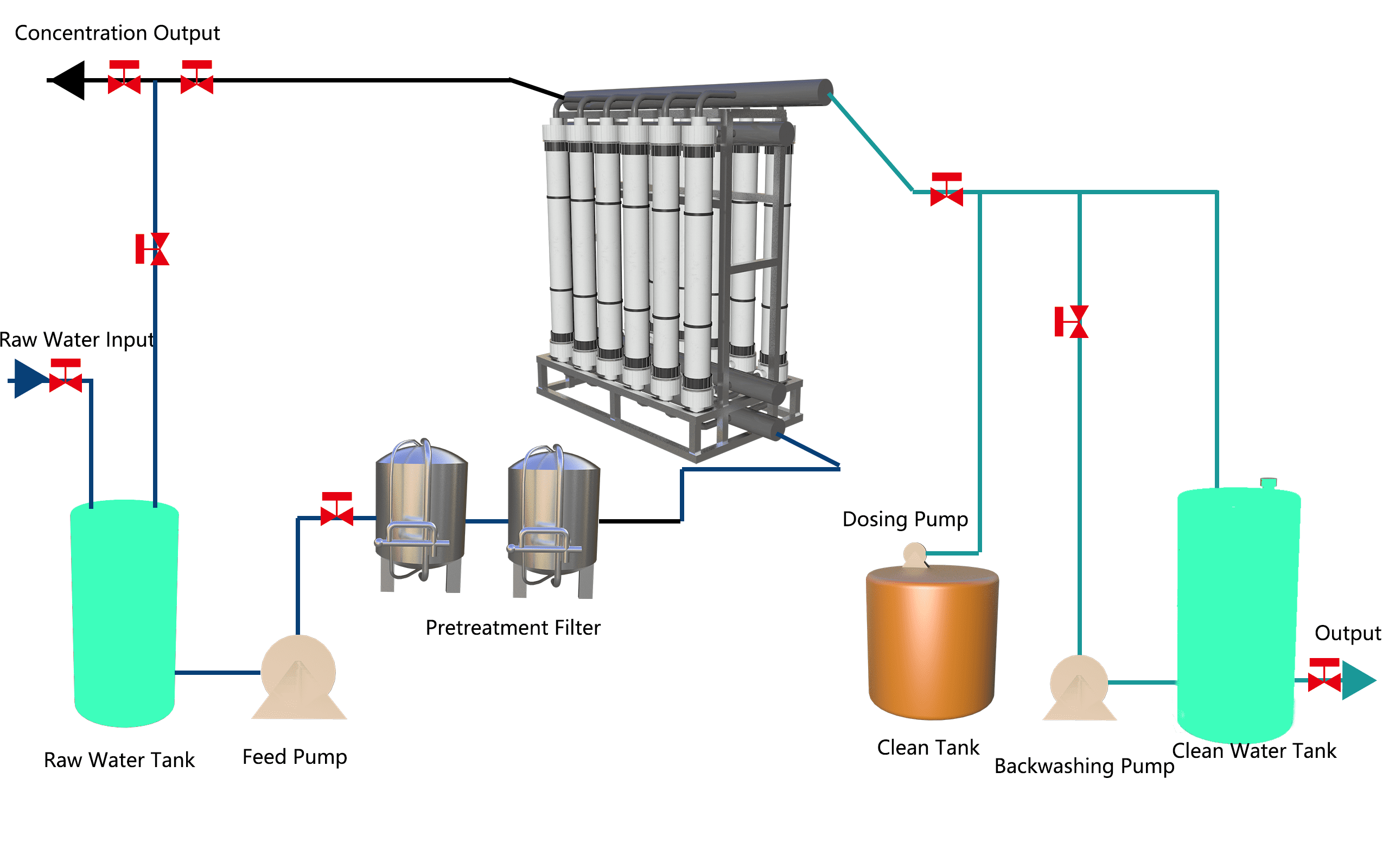
1. Ultrafiltration membrane
Ultrafiltration membrane is a key part of ultrafiltration structure, and its main function is to realize the separation and filtration of substances in water. Ultrafiltration membrane can be divided into hollow fiber membrane, flat membrane, semi-permeable membrane and other forms. Among them, hollow fiber membrane is the most widely used one, its material can be used polypropylene, polyester, polysulfone and other materials.
2. Support layer
The support layer is the bottom layer of the ultrafiltration membrane and is mainly used to provide support and stabilize the structure of the membrane. The support layer can be made of a variety of materials, such as stainless steel, plastic, ceramic, etc.
3. Water inlet and outlet pipes
Water inlet and outlet pipes are important channels to introduce and discharge water into and out of the structure, usually made of PVC, stainless steel and other materials. In order to ensure the smooth flow of water in and out, the design of water in and out pipes is also critical.
4. Control systems
The control system of ultrafiltration structure of sewage treatment can adopt automatic control to ensure the normal operation and stability of the structure. The control system includes quality monitoring system, flow control system, self-cleaning system and alarm system.
These are the main components of ultrafiltration structure of sewage treatment, among which ultrafiltration membrane is the most critical part. We need to choose different composition of ultrafiltration structure according to different water quality and quantity to obtain better treatment effect.

Principle of ultrafiltration
As a new efficient separation technology, membrane treatment technology has been rapidly applied in water treatment, environmental protection, medicine, food, chemical and other fields in recent years because of its simple process, convenient operation, compact equipment, good separation effect and high economy. Membrane treatment technology plays a very important role in solving the problem of water shortage. In the recycling of water and wastewater, the special role of membrane is very important, especially in the areas where water supply is scarce, and it has attracted wide attention.
Microfiltration, ultrafiltration, nanofiltration and reverse osmosis are all external force driven membrane treatment technologies. At present, among several main membrane separation technologies, ultrafiltration and reverse osmosis are the most widely used.
Ultrafiltration process is a solution separation process driven by the pressure difference between the two sides of the membrane and based on mechanical screening. The pore size of ultrafiltration membrane is 0.005 ~ 1.0μm. Substances smaller than the pore size of the ultrafiltration membrane and substances dissolved in water can be used as permeable liquid to pass through the filter membrane, and substances that cannot pass through the filter membrane will be intercepted and concentrated in the discharge liquid. As a result, the produced water (through solution) contains water, ions and small molecular substances, while colloidal substances, particles, bacteria, viruses and protozoa will be removed by the membrane. The membrane separation process is a dynamic filtration process, and the macromolecular solute is blocked by the membrane and flows out of the membrane component with the concentrated solution. The membrane is not easy to be blocked and can be used continuously for a long time. Ultrafiltration process can be operated at room temperature and low pressure, no phase change, high efficiency and energy saving.

The water to be filtered is pressurized by the ultrafiltration feed pump and transported to the membrane module. Due to the pressure difference between the inside and outside the membrane, the water penetrates the filter membrane, while the impurities in the water are intercepted and cannot penetrate the filter membrane. If the separated impurities are deposited too much on the membrane, the insoluble salts will gather on the surface of the membrane to form a coating layer and then scale. In order to avoid this, impurities are often allowed to flow out with part of the water as a concentrate during the separation process. Depending on the membrane type and application, this process may be carried out continuously or during reflux. Compared with traditional purification methods such as flocculation, precipitation and sand filtration, ultrafiltration has stable water quality, simple equipment management, and does not produce filtration residue or flocculated sludge and other wastes.
Ultrafiltration membrane and ultrafiltration assembly
When ultrafiltration is used in water treatment, the chemical stability and hydrophilicity of the material are the two most important properties. Chemical stability determines the life of materials under the action of acid and alkali, oxidants and microorganisms, and is directly related to the method that can be taken for cleaning; Hydrophilicity determines the adsorption degree of membrane materials to organic pollutants in water and affects the flux of membrane. There are various types and specifications of ultrafiltration membrane, which can be selected according to actual needs.

1. Chemical materials required for ultrafiltration membrane preparation
There are many materials for making ultrafiltration membrane, but the materials used for making hollow fiber ultrafiltration membrane are mainly polymer materials with good fiber forming performance. The requirements for membrane materials are good film formation, thermal stability, chemical stability, acid and alkaline resistance, microbial erosion resistance and oxidation resistance, and good hydrophilicity to obtain high water flux and anti-pollution ability. At present: the commonly used hollow fiber ultrafiltration membrane materials are polyvinylidene fluoride (PVDF), polyether sulfone (PFS), polysulfone (PS), polyvinyl chloride (PVC), polyethylene (PF), polyacrylonitrile (PAN), polypropylene (PP), etc. Polyvinylidene fluoride and polyethersulfone are the most widely used ultrafiltration membrane materials.
2. Structure of ultrafiltration membrane assembly
Ultrafiltration membrane can be generally divided into plate and frame type (plate type), roll type, tube type, hollow fiber type and other structures.
Plate ultrafilltration membrane is the most original membrane structure, mainly used for the separation of large particulate matter, due to its large footprint, high energy consumption, gradually eliminated by the market.
Coil membrane module is also known as spiral coil membrane module. Because the membrane used is easy to be industrialized on a large scale, and the prepared components are also easy to be industrialized, it has been widely used, covering four membrane separation processes of reverse osmosis, nanofiltration, ultrafiltration and microfiltration, and has the highest utilization rate in the field of reverse osmosis and nanofiltration.
Tubular ultrafiltration membrane can withstand suspended solids, fiber, protein and other substances in a large range, low pre-treatment requirements for the material liquid, high concentration of the material liquid can be carried out, but the investment cost of equipment is high, covers a large area.
Among the many membrane module structure forms, the hollow fiber ultrafiltration membrane is mainly used at present. The structure of the module should be considered to improve the packing density of the membrane as much as possible, increase the water yield per unit volume, minimize the influence of concentration polarization, facilitate cleaning and low manufacturing cost.

At present, hollow fiber ultrafiltration membrane has become the main form of ultrafiltration due to its incomparable advantages. According to the different position of the dense layer, the hollow fiber ultrafiltration membrane can be divided into internal pressure membrane and external pressure membrane. The external pressure hollow fiber filter membrane penetrates the stock solution through the hollow fiber along the dimensional superradial from the outside to the inside to become the permeable liquid, and the material trapped by it sinks in the outside of the hollow fiber. The inlet channel of the membrane is between the membrane filaments, and the membrane filaments have a certain free movement space, so it is more suitable for the situation of poor raw water quality and high suspended matter content. The stock liquid in the internal pressure hollow fiber type ultrafiltration membrane enters the inside of the hollow fiber, and is driven by the pressure difference, passing through the hollow fiber from inside to outside along the radial direction to become the permeation liquid, while the concentrated liquid stays in the inside of the hollow fiber and flows out from the other end. The membrane inlet passage is the inner cavity of hollow fiber, in order to prevent blockage, there are strict requirements on the particle size and content of the inlet water, so it is suitable for the working condition of good raw water quality.
3. Interception performance of ultrafiltration membrane assembly
(1) Interception of particles. The turbidity of the filtrate can usually be reduced below 0.1NTU using ultrafiltration. In the case of unstable turbidity of raw water: the use of ultrafiltration is more appropriate. Compared to conventional purification processes, ultrafiltration can be automated very easily.
(2) Interception of organic matter. Organic matter includes particles, colloids and water-soluble organic matter. Because the ability of ultrafiltration to intercept different types of organic matter is different, the purification efficiency depends on the composition of organic matter in the water. Compared with the traditional method, the ultrafiltration method does not need to consider precipitation, and does not need to pay attention to the filterability of the condensate, because the purification efficiency of ultrafiltration has nothing to do with the shape and density of the condensate. Depending on the flocculation and the quality of raw water, the retention rate of organic matter by ultrafiltration is 40% to 60%.
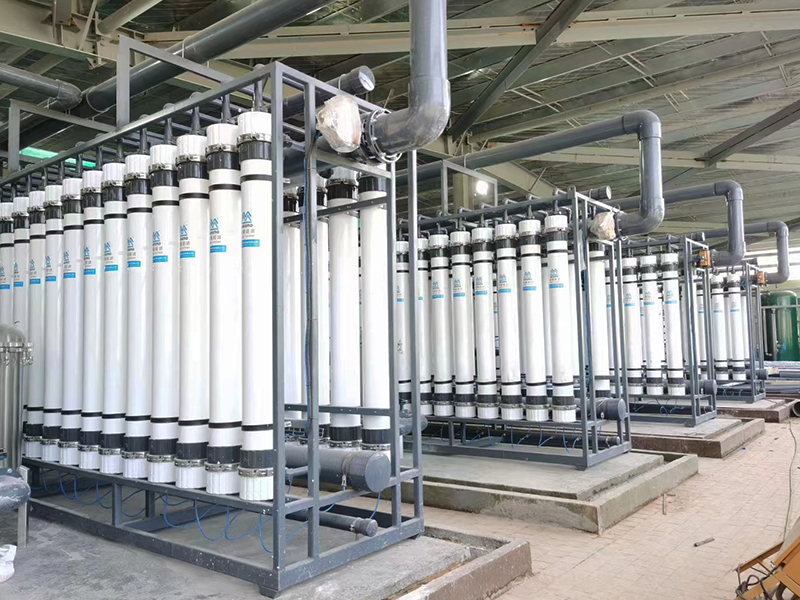
Operation and maintenance of ultrafiltration system
The operation of ultrafiltration system has two modes: full flow filtration and cross flow filtration. In full-flow filtration, all the incoming water passes through the membrane surface to become water production; In cross-flow filtration, part of the water passes through the membrane surface to become water, and the other part is discharged with impurities to become concentrated water. Low energy consumption, low operating pressure, thus lower operating costs; Cross-flow filtration can handle fluids with higher suspended solids content. When the filtrate flux of ultrafiltration is low and the filtration load of ultrafiltration membrane is low, the pollutants formed on the membrane surface are easy to be removed, so the long-term filtrate flux is stable. When the filtrate flux is high, the tendency of unrecoverable fouling of ultrafiltration membrane increases, and the recovery rate of cleaning fluid decreases, which is not conducive to maintaining the stability of filtrate flux for a long time.
Mode of filtering:
1. Full-stream filtering mode
Generally, when the content of suspended solids and colloidals in raw water is low (such as SS< 5, turbidity < 5NTU). Raw water enters the membrane tube at a low cross-flow rate, while concentrated water is discharged from the other end of the membrane tube at a certain proportion. The water produced is produced on the filtrate side of the membrane tube, and the water recovery rate is usually 90% ~ 99%, which is determined by the quality of the raw water. Compared with the circulating mode, the operating cost of the full-flow filtration mode is lower, but the water recovery rate and the effluent capacity of the system may be limited. This mode usually requires periodic fast flushing and recoil to maintain the system output, and when the dirt accumulates to a certain extent, it needs to be treated by chemical cleaning.
2. Cross-flow filtering mode
The high content of suspended solids in raw water and in most non-aqueous applications require a reduction in the recovery rate to maintain a high flow rate inside the membrane tube, resulting in a large amount of wastewater. To avoid waste, the discharged concentrated water is re-pressurized back into the membrane tube. In this way, although the recovery rate of the membrane tube is reduced, for the whole system, the recovery rate is still high. In this mode, the influent water circulates continuously on the membrane surface, and the high-speed circulating water prevents the accumulation of particles on the membrane surface and increases the filtrate flux. Because less incoming water becomes produced water, the energy consumption of the cross-flow filtration mode is greater than that of the full-flow filtration mode in order to achieve the same yield.
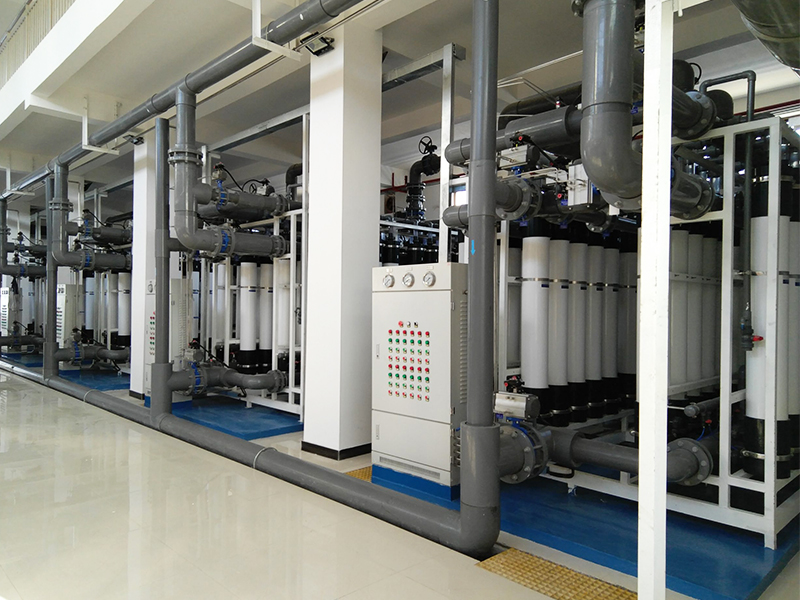
Operation of ultrafiltration membrane
The ultrafiltration membrane should be checked and started before operation according to the following steps:
(1) Inlet water quality inspection. The key is to check the turbidity of the inlet water. When the turbidity is within the limited value range of the system, the ultrafiltration equipment can be operated, followed by checking the residual chlorine content and pH value in the water.
(2) System check. According to the process roadmap, check whether the equipment and connection are correct, and check whether the valve is open correctly. Special attention should be paid to the manually operated system. The inlet valve should not be fully opened when the machine is started, and the concentrated water valve and the water producing valve should be fully open to avoid the excessive pressure when the machine is started, which will cause the impact on the ultrafiltration membrane and damage the equipment.
(3) Instrument inspection. Check whether all instruments are normal, especially whether the pressure gauge is intact.
(4) Start. When the preparation work before starting up. Can test start the system, that is, turn on the power supply, start the pump, immediately stop, check whether the pump impeller steering is correct, pump operation has no abnormal noise. When the pump is confirmed to be normal, the pump can be officially started. After starting, the interface and pipeline should be checked for leakage. In the first cycle of automatic control program operation, the opening and closing of the valve should be checked, and the operation of various instruments should be normal.
⑸ Operation. When the equipment is running, it should be regularly checked whether the instrument is normal, whether the pump has abnormal noise, whether the water quality meets the requirements, especially pay attention to the pressure gauge and water flow, when abnormal, it should be immediately stopped for inspection. Generally, the self-protection of the system is considered when the automatic control is designed. If there is any abnormality, the system will automatically stop operation and alarm. During the operation of the equipment, the equipment should be monitored and recorded according to the design requirements; Clean, sterilize and disinfect the equipment regularly according to the design requirements; The equipment should be vented regularly or the working status of the automatic exhaust valve should be checked.
⑹ Shutdown.
① First reduce the system pressure and transmembrane pressure difference, and then shut down.
② When the shutdown time does not exceed 7 days, the protective operation of the equipment can be carried out for 20 ~ 60min every day (the time is subject to a filtration, flushing, backwashing and flushing cycle), so that the fresh water can be replaced with the water stored in the equipment.
③ When the equipment is out of use for a long time, the equipment should be thoroughly cleaned and disinfected first, and then the membrane protective agent and antibacterial agent are injected into the equipment, and all interfaces of the equipment are closed to keep the membrane wet and prevent bacteria and algae from growing in the equipment.
Contamination of ultrafiltration membrane
Membrane pollution refers to the process in which particles, colloides or solute macromolecules in the material solution adsorb and deposit on the surface of the membrane through physical adsorption, chemical action or mechanical interception, resulting in the blockage of membrane pores, and the obvious change of membrane permeation flux and separation characteristics. Membrane adsorption in ultrafiltration process is considered to be the key to membrane fouling, which is related to the interaction of membrane, solvent and solute. Due to the different chemical properties and structures of membrane components, the mechanism of adsorption is also different, which can be generally divided into electrostatic interaction, hydrophobic interaction and so on.
Cleaning of ultrafiltration system
In the process of ultrafiltration, the separated substances and other impurities will gradually accumulate on the membrane surface, resulting in pollution and blockage of the membrane. Therefore, the cleaning of the membrane is an indispensable operation process in the ultrafiltration system, and the effective cleaning of the membrane is an important means to extend the service life of the membrane. The commonly used cleaning methods of ultrafiltration membrane mainly include physical cleaning and chemical cleaning. The cleaning of ultrafiltration system includes water forward washing and backwashing, gas washing, chemical cleaning and so on. Among them, the forward washing and backwashing of water can remove the filter cake layer on the membrane surface; The gas method uses the strong turbulence of gas to remove the pollution layer on the membrane surface more effectively. Chemical cleaning through chemical reaction to remove colloids, organic matter, inorganic salts and other impurities on the surface of ultrafiltration membrane and internal water formation.
Ultrafiltration system backwash
Ultrafiltration backwashing water is ultrafiltration production water, because the suspended solids brought in by backwashing water will gather in the support structure and then constantly release particles, bacteria and TOC, so raw water is not suitable for backwashing water.
With the long-term use of ultrafiltration membrane components, impurities in water will be deposited on the membrane, which will gradually affect the separation performance of the membrane. Therefore, in operation, when the water yield of the ultrafiltration membrane decreases by more than 20% or when it is used for 1 to 4 months, it is necessary to carry out chemical cleaning of the ultrafiltration into the ultrafiltration membrane, so as to timely remove the pollutants on the ultrafiltration membrane, prevent the formation of refractory scaling of the ultrafiltration membrane, and timely restore the performance of the membrane.

Chemical cleaning is divided into acid solution cleaning and alkaline solution cleaning. When the hardness of the inlet water is high or the content of metal ions (such as iron ions) exceeds the design standard, thus causing inorganic pollution to the inlet side of the membrane, it is necessary to use acidic solution to clean the ultrafiltration device. For bio-contaminated ultrafiltration membrane, alkaline solution should be used to clean the ultrafiltration membrane device. The following points should be noted when cleaning:
(1) All cleaning agents must enter the assembly from the water inlet side of the ultrafiltration system to prevent impurities that may exist in the cleaning agent from the back of the dense filter layer into the interior of the membrane wall.
(2) The ultrafiltration system is thoroughly backwashed before chemical cleaning.
(3) The entire chemical cleaning process of ultrafiltration system takes 2 ~ 4h; If the fouling is serious, it needs to be soaked for more than 12h.
(4) After cleaning, if the shutdown time of the ultrafiltration system exceeds three days, the ultrafiltration system must be maintained according to the requirements of long-term shutdown.
(5) The cleaning solution must be prepared with ultrafiltration water or better quality water.
(6) Cleaning agent must remove possible contaminants before circulating into the membrane assembly
The temperature of the cleaning solution can be controlled at 10 ~ 40℃, and increasing the temperature of the cleaning solution can improve the cleaning efficiency.
(7) when necessary, can use a variety of cleaning agent cleaning, but cleaning agent and fungicide can not cause damage to the membrane and component materials. After each cleaning, exhaust the cleaning agent and rinse the system with ultrafiltration or reverse osmosis water before cleaning with another cleaning agent.
Chemical cleaning of reverse osmosis membranes should not be too frequent to prevent irreversible damage to membrane elements.
description2

